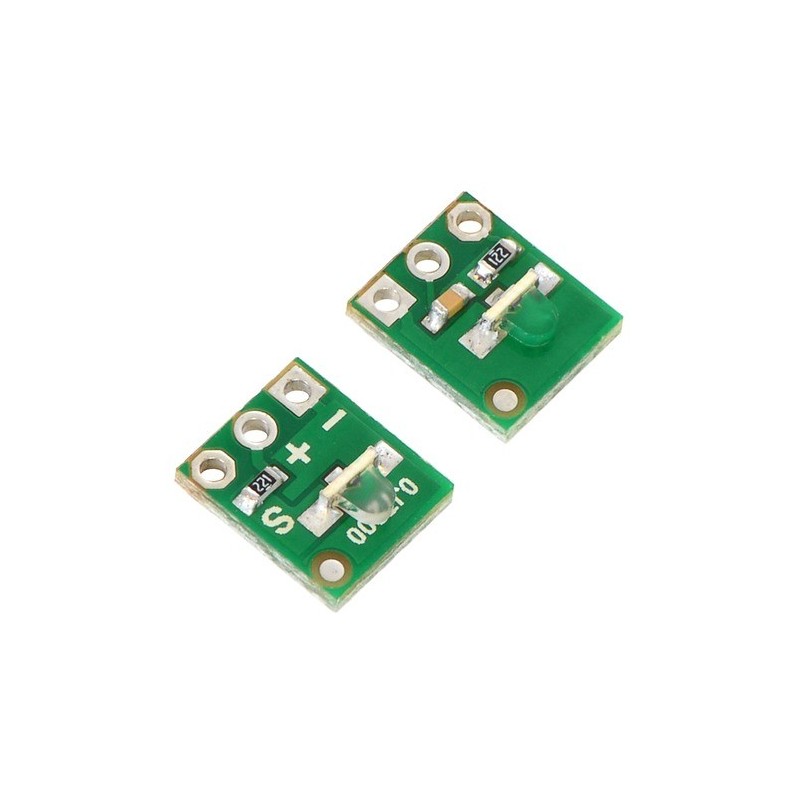

The QTR-L-1RC reflectance sensor incorporates a right-angle infrared LED and a right-angle phototransistor in an inexpensive, tiny 0.35" A— 0.3" module that can be mounted almost anywhere and is great for edge detection and line following. The output is designed to be measured by a digital I/O line. This sensor is sold in packs of two units.
Note: The QTR-L-1RC reflectance sensor requires a digital I/O line to take readings. The similar QTR-L-1A reflectance sensor is available with an analog output.
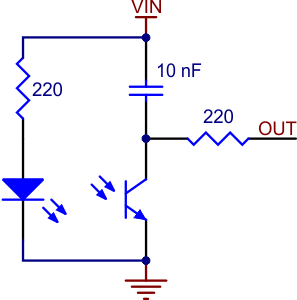 |
The Pololu QTR-L-1RC reflectance sensor carries a right-angle infrared LED and a right-angle phototransistor, both pointing toward the front edge of the board. The phototransistor uses a capacitor discharge circuit that allows a digital I/O line on a microcontroller to take an analog reading of reflected IR by measuring the discharge time of the capacitor. Shorter capacitor discharge time is an indication of greater reflection.
The LED current-limiting resistor is set to deliver approximately 17 mA to the LED when VIN is 5 V. The current requirement can be met by some microcontroller I/O lines, allowing the sensor to be powered up and down through an I/O line to conserve power.
This sensor was designed to be used with the board perpendicular to the surface being sensed, and narrow-angle lenses built into the infrared LED and phototransistor packages allow it to be effective to a range of about 1" (25 mm). Because of its small size, multiple units can easily be arranged to fit various applications such as line sensing and proximity/edge detection. The QTR-L-1RC is sold in packs of two units.
For a similar sensor that can be used with the board parallel to the surface, but with shorter range, please see the QTR-1RC reflectance sensor. We also offer arrays of three and eight sensors: the QTR-3RC reflectance sensor array and the QTR-8RC reflectance sensor array.
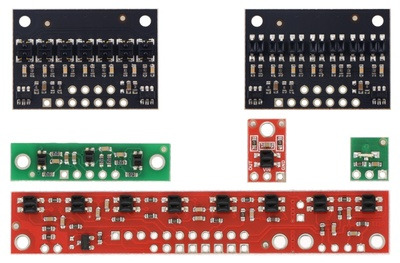 |
| QTR sensor size comparison. Clockwise from top left: QTR-3RC, QTR-1RC, QTR-L-1RC, QTR-8RC. |
|---|
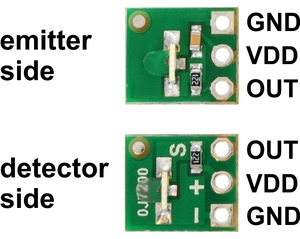 |
Like the Parallax QTI, the QTR-L-1RC module has sensor outputs that require a digital I/O line capable of first charging the output capacitor (by driving the line high) and then measuring the time for the capacitor to discharge through the phototransistor. This measurement approach has several advantages, especially when multiple units are used:
The typical sequence for reading a sensor is:
These steps can typically be executed in parallel on multiple I/O lines.
With a strong reflectance, the discharge time can be as low as several dozen microseconds; with no reflectance, the discharge time can be up to a few milliseconds. The exact time of the discharge depends on your microcontroller’s I/O line characteristics. Meaningful results can be available within 1 ms in typical cases (i.e. when not trying to measure subtle differences in low-reflectance scenarios), allowing up to 1 kHz sampling. The following table shows some typical discharge times (from 5 V down to a 2 V threshold) of the sensor over different surfaces and at different distances:
| White surface | 3/4" black electrical tape | |
|---|---|---|
| 0.25" distance | 100 ÎLs | 320 ÎLs |
| 1" distance | 160 ÎLs | 260 ÎLs |
Ambient light, especially sunlight, can affect the sensor readings significantly. If the discharge time of the QTR-L-1RC is consistently low, you might need to add shielding around the sensor or mount it in a different location to reduce interference from outside light sources.
Our Pololu AVR library provides functions that make it easy to use these sensors with our Orangutan robot controllers; please see the QTR Reflectance Sensors section of our library command reference for more information. We also have a Arduino library for these sensors.
Each pack of two reflectance sensors includes sets of straight male header strips and right-angle male header strips, which allow you to mount them in the orientation of your choice. You can also solder wires, such as ribbon cable, directly to the pads for the most compact installation.
|
|
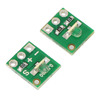 |
QTR-L-1A Reflectance Sensor (2-Pack) |
 |
QTR-1RC Reflectance Sensor |
 |
Female Crimp Pins for 0.1" Housings 100-Pack |
Producent BTC Korporacja sp. z o. o. Lwowska 5 05-120 Legionowo Polska sprzedaz@kamami.pl 22 767 36 20
Osoba odpowiedzialna BTC Korporacja sp. z o. o. Lwowska 5 05-120 Legionowo Polska sprzedaz@kamami.pl 22 767 36 20
Moduł z analogowym czujnikiem TEMT6000. Napięcie na wyjściu zwiększa się wraz ze wzrostem natężenia padającego światła. Czujnik zasilany jest napięciem 5 V
Moduł z 10-kanałowym czujnikiem AS7341 pozwalający na wykrywanie światła w różnych zakresach długości fali (detekcja kolorów). Komunikuje się przez interfejs I2C. Adafruit 4698
Wielofunkcyny moduł z sensorem optycznym do pomiaru natężenia oświetlenia, koloru padającego światła RGB, odległości od obiektu i detekcji gestów 3D. Adafruit 3595
Moduł z czujnikiem światła SI1151, który może wykrywać fale o szerokim zakresie długości: światła widzialnego oraz podczerwonego. Płytka została wyposażona w złącze Grove i komunikuje się przez interfejs I2C. Seeed Studio 101020089
Brak towaru
Moduł z czujnikiem światła (fotorezystorem) przeznaczony do zestawów M5Stack. Na złączu Grove wyprowadzone zostało wyjście analogowe oraz wyjście cyfrowe. M5Stack U021
Moduł ze czujnikiem zbliżeniowym i światła otoczenia oparty na układzie VCNL4020. Pozwala na wykrywanie przeszkód w zakresie od 0 do 20 cm oraz pomiar natężenia światła od 0,26 do 16 000 lux. Komunikuje się poprzez magistralę I2C. Adafruit 5810
Moduł z czujnikiem natężenia światła TSL2591. Wyposażony w złacze STEMMA QT z interfejsem I2C. Adafruit 1980
Czujnik do wykrywania odległości, natężenia i częstotliwości błyskawic w promieniu 40 km. Moduł umożliwia entuzjastom pogodowym mierzenie danych o lokalnych burzach. SparkFun SEN-15441
Brak towaru
Kompaktowy moduł z trzema czujnikami I2C, umożliwiający pomiar temperatury, wilgotności, ciśnienia, światła, zbliżenia oraz ruchu. Oferuje dwa złącza Qw/ST, dzięki czemu szybko podłączysz go do Raspberry Pi, Pico lub innych mikrokontrolerów. Idealny do aplikacji IoT, automatyki domowej i analizy środowiska w mobilnych lub stacjonarnych projektach. Pimoroni PIM745
Moduł z 11-kanałowym czujnikiem AS7341 pozwalający na wykrywanie światła w różnych zakresach długości fali (detekcja kolorów). Komunikuje się przez interfejs I2C. DFRobot SEN0365
Brak towaru
Moduł z czujnikiem światła w postaci fotorezystora. Na płytce umieszczono komparator i potencjometr. Moduł ma wyjście cyfrowe
Brak towaru
Moduł czujnika odległości działający w technologii ToF, zakres działania 1-20 cm (przy zmniejszonej rozdzielczości do 60 cm), rozdzielczość do 1 mm. Komunikacja z czujnikiem poprzez magistralę I2C. Zasilanie poprzez wbudowany regulator napięciem od 2,7 do 5,5 V. Pololu 2489
Moduł z czujnikiem VCNL4200 łączący detekcję odległości i pomiar światła otoczenia, idealny do aplikacji takich jak robotyka czy automatyka domowa. Dzięki technologii podczerwieni, zasięg detekcji wynosi do 1,5 metra, a wbudowany czujnik ALS umożliwia pomiar natężenia światła w zakresie 0.003 do 1570 lux, co czyni go wszechstronnym rozwiązaniem do monitorowania warunków oświetleniowych. Adafruit 6064
Moduł z czujnikiem światła w postaci fotorezystora. Na płytce umieszczono komparator i potencjometr. Moduł ma wyjście cyfrowe
Czujnik koloru wyposażony w sensor OPT4048 od Texas Instruments. Pozwala na wyznaczenie charakterystyki światła otoczenia poprzez pomiar takich parametrów, jak natężenie światła, kolor w układach współrzędnych CIE XY, LUV, a także temperatura barwowa. Moduł wyposażony został w złącza Qwiic. SparkFun SEN-22638
Brak towaru

